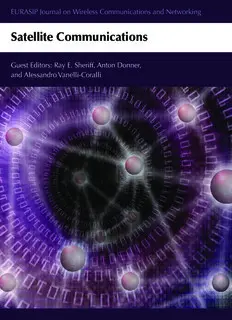
Satellite Communications PDF
Preview Satellite Communications
EURASIP Journal on Wireless Communications and Networking Satellite Communications Guest Editors: Ray E. Sheriff, Anton Donner, and Alessandro Vanelli-Coralli Satellite Communications EURASIP Journal on Wireless Communications and Networking Satellite Communications Guest Editors: Ray E. Sheriff, Anton Donner, and Alessandro Vanelli-Coralli Copyright©2007HindawiPublishingCorporation.Allrightsreserved. Thisisaspecialissuepublishedinvolume2007of“EURASIPJournalonWirelessCommunicationsandNetworking.”Allarticlesare openaccessarticlesdistributedundertheCreativeCommonsAttributionLicense,whichpermitsunrestricteduse,distribution,and reproductioninanymedium,providedtheoriginalworkisproperlycited. Editor-in-Chief LucVandendorpe,Universite´ CatholiquedeLouvain,Belgium Associate Editors ThusharaAbhayapala,Australia DavidGesbert,France MarcMoonen,Belgium MohamedH.Ahmed,Canada FaryZ.Ghassemlooy,UK EricMoulines,France FaridAhmed,USA ChristianHartmann,Germany SayandevMukherjee,USA AlaganAnpalagan,Canada StefanKaiser,Germany KameswaraRaoNamuduri,USA AnthonyBoucouvalas,Greece G.K.Karagiannidis,Greece AmiyaNayak,Canada LinCai,Canada ChiChungKo,Singapore A.Pandharipande,TheNetherlands BiaoChen,USA VisaKoivunen,Finland AthinaPetropulu,USA Yuh-ShyanChen,Taiwan RichardKozick,USA A.LeeSwindlehurst,USA PascalChevalier,France BhaskarKrishnamachari,USA SergiosTheodoridis,Greece Chia-ChinChong,SouthKorea S.Lambotharan,UK GeorgeS.Tombras,Greece HuaiyuDai,USA VincentLau,HongKong LangTong,USA SouraDasgupta,USA DavidI.Laurenson,UK AthanasiosV.Vasilakos,Greece IbrahimDeveli,Turkey ThoLe-Ngoc,Canada WeidongXiang,USA PetarM.Djuric´,USA WeiLi,USA YangXiao,USA MischaDohler,France YonghuiLi,Australia XueshiYang,USA AbrahamO.Fapojuwo,Canada TongtongLi,USA LawrenceYeung,HongKong MichaelGastpar,USA ZhiqiangLiu,USA DongmeiZhao,Canada AlexGershman,Germany StephenMcLaughlin,Scotland WeihuaZhuang,Canada WolfgangGerstacker,Germany SudipMisra,Canada Contents SatelliteCommunications,RayE.Sheriff,AntonDonner,andAlessandroVanelli-Coralli Volume2007,ArticleID58964,2pages Multi-SatelliteMIMOCommunicationsatKu-BandandAbove:InvestigationsonSpatialMultiplexing forCapacityImprovementandSelectionDiversityforInterferenceMitigation,KonstantinosP.Liolis, AthanasiosD.Panagopoulos,andPanayotisG.Cottis Volume2007,ArticleID59608,11pages InvestigationsinSatelliteMIMOChannelModeling:AccentonPolarization,Pe´terHorva´th, GeorgeK.Karagiannidis,PeterR.King,StavrosStavrou,andIstva´nFrigyes Volume2007,ArticleID98942,10pages PerformanceAnalysisofSSCDiversityReceiversoverCorrelatedRiceanFadingSatelliteChannels, PetrosS.BithasandP.TakisMathiopoulos Volume2007,ArticleID25361,9pages AdvancedFadeCountermeasuresforDVB-S2SystemsinRailwayScenarios,StefanoCioni, CristinaPa´rragaNiebla,GonzaloSecoGranados,SandroScalise,AlessandroVanelli-Coralli, andMar´ıaAngelesVa´zquezCastro Volume2007,ArticleID49718,17pages CapacityVersusBitErrorRateTrade-OffintheDVB-S2ForwardLink,MatteoBerioli, ChristianKissling,andRe´miLapeyre Volume2007,ArticleID14798,10pages FrequencyEstimationinIterativeInterferenceCancellationAppliedtoMultibeamSatelliteSystems, J.P.Millerioux,M.L.Boucheret,C.Bazile,andA.Ducasse Volume2007,ArticleID62310,12pages AQoSArchitectureforDVB-RCSNextGenerationSatelliteNetworks,ThierryGayraudand PascalBerthou Volume2007,ArticleID58484,9pages MaximumLikelihoodTimingandCarrierSynchronizationinBurst-ModeSatelliteTransmissions, MicheleMorelliandAntonioA.D’Amico Volume2007,ArticleID65058,8pages BurstFormatDesignforOptimumJointEstimationofDoppler-ShiftandDoppler-RateinPacket SatelliteCommunications,LucaGiugno,FrancescaZanier,andMarcoLuise Volume2007,ArticleID29086,12pages TCP-CallAdmissionControlInteractioninMultiplatformSpaceArchitectures,GeorgiosTheodoridis, CesareRoseti,NioviPavlidou,andMicheleLuglio Volume2007,ArticleID23923,8pages EfficientDelayTrackingMethodswithSidelobesCancellationforBOC-ModulatedSignals, AdinaBurian,ElenaSimonaLohan,andMarkkuKaleviRenfors Volume2007,ArticleID72626,20pages AnalysisofFilter-Bank-BasedMethodsforFastSerialAcquisitionofBOC-ModulatedSignals, ElenaSimonaLohan Volume2007,ArticleID25178,12pages HindawiPublishingCorporation EURASIPJournalonWirelessCommunicationsandNetworking Volume2007,ArticleID58964,2pages doi:10.1155/2007/58964 Editorial Satellite Communications RayE.Sheriff,1AntonDonner,2andAlessandroVanelli-Coralli3 1MobileandSatelliteCommunicationsResearchCentre,SchoolofEngineering,DesignandTechnology,UniversityofBradford, RichmondRoadBradfordBD71DP,UK 2GermanAerospaceCenter,InstituteofCommunicationsandNavigation,Oberpfaffenhofen,82234Wessling,Germany 3ARCES,UniversityofBologna,ViaToffano2,40125Bologna,Italy Received28November2007;Accepted9December2007 Copyright©2007RayE.Sheriffetal.ThisisanopenaccessarticledistributedundertheCreativeCommonsAttributionLicense, whichpermitsunrestricteduse,distribution,andreproductioninanymedium,providedtheoriginalworkisproperlycited. We are delighted to bring to you this special issue on satel- ing:accentonpolarization”looksatMIMOsystemsfromthe litecommunications,whichwehavepreparedaspartofthe polarizationdiversitypointofviewanddwellsonthesatellite spreading of excellence remit of the satellite communica- cooperativecommunicationconcepts. tions network of excellence (SatNEx). The SatNEx project, Switch and stay combining (SSC) is a form of diversity whichbeganin2004,isfundedforfiveyearsundertheEuro- technique used in digital receivers to compensate for fade peanUnion’sSixthFrameworkProgramme(FP6)Informa- events introduced by the mobile channel. The third paper tion Society Technologies (IST) Thematic Area. Led by the “PerformanceanalysisofSSCdiversityreceiversovercorre- GermanAerospaceCenter,SatNExbringstogetheranetwork lated Ricean fading satellite channels” investigates the per- of 24 partners, distributed throughout Europe, with mem- formance of dual-branch SSC receivers for different fading bershipdrawnfromtencountries. channelcharacteristics. The philosophy underlying the SatNEx approach re- The next four papers deal with the emerging scenario volves around the selection of focused actions under Joint ofmobiledigitalvideobroadcasting(DVB-S2andRCSmo- ProgrammesofActivities,whicharecarriedoutcollectively bile). Alternative approaches to counteracting fading chan- by the partners and include research, integration, and dis- nels introduced when operating in a train environment re- seminationactivities.Trainingrepresentsanimportantpart ceiving satellite DVB-S2 are presented in the paper “Ad- oftheSatNExremitandissupportedthroughanumberof vancedfadecountermeasuresforDVB-S2systemsinrailway initiativesincludingthehostingofinternshipprojectsandan scenarios.” Here, as a result of simulation analysis, antenna annualsummerschool. diversity and packet-level forward error correction mecha- Thecallforpapersresultedinahighnumberofsubmis- nismsareproposedandtheirimpactisevaluatedwithrespect sions, from which we have been able to select 12 excellent tothereceiverdesignandsystemcomplexity.Thethemeof papersdealingwiththedifferentaspectsofsatellitecommu- DVB-S2iscontinuedwiththepaper“Capacityversusbiter- nicationsandnavigation. rorratetrade-offintheDVB-S2forwardlink,”whichinves- Multiple-inputmultiple-output(MIMO)techniquesare tigates how satellite capacity can be optimised for DVB-S2 attracting a considerable amount of attention from within transmissions. The DVB return channel via satellite (DVB- theterrestrialwirelesscommunity.Thefirstpaperofthisspe- RCS)isthenaddressedin“Frequencyestimationiniterative cialissue,“MultisatelliteMIMOcommunicationsatKuband interference cancellation applied to multibeam satellite sys- andabove:investigationsonspatialmultiplexingforcapac- tems,”whichconsiderstheapplicationofinterferencecancel- ityimprovementandselectiondiversityforinterferencemit- lationonthereverselinkofamultibeamsatellitesystem,us- igation,”considerstheapplicationofsuchtechnologyovera ingDVB-RCSwithconvolutionalcodingasanexample.The satellite platform operating in the Ku band and above. The paper “A QoS architecture for DVB-RCS next-generation paperconsidershowMIMOcanbeusedtoincreasecapac- satellitenetworks”proceedstodesignandemulateaquality- ity by using a satellite spatial multiplexing system and how of-service (QoS) architecture that demonstrates using real antenna selection can be used to mitigate interference. The multimedia applications how QoS can be supported over a nextpaper“InvestigationsinsatelliteMIMOchannelmodel- DVB-RCSnetwork. 2 EURASIPJournalonWirelessCommunicationsandNetworking Synchronization aspects are dealt with in “Maximum likelihoodtimingandcarriersynchronizationinburst-mode satellitetransmissions.”Thepaperaddressestheproblemof achieving synchronisation for a burst-mode satellite trans- missionoveranAWGNchannel.Thesubjectofbursttrans- mission continues with the paper “Burst format design for optimum joint estimation of Doppler-shift and Doppler- rate in packet satellite communications,” which considers optimising the burst-format of packet-oriented transmis- sionsbyproposingvery-low-complexityalgorithmsforcar- rierDoppler-shiftandDoppler-rateestimation. A network comprising satellite and high-altitude plat- forms is considered in the paper “TCP-call admission con- trolinteractioninmultiplatformspacearchitectures.”Cross- layertechniquesareimplementedbymeansofTCPfeeding back into call admission control (CAC) procedures for the purpose of prevention of congestion and improvement in QoS. Finally, since navigation is an extremely important part of the satellite system family, we have included two papers. Thefirstpaper“Efficientdelaytrackingmethodswithside- lobescancellationforBOC-modulatedsignals”dealswithbi- nary offset carrier (BOC) modulation, which is adopted in typicalnavigationsystems.Thepaperconsidershowtoim- provethetrackingofthemainlobeoftheBOC-modulated signalbyusingsidelobesuppressiontechniques.Analterna- tiveapproachbasedonfilterbankprocessingispresentedin “Analysis of filter-bank-based methods for fast serial acqui- sitionofBOC-modulatedsignals”toconcludethespecialis- sue. ACKNOWLEDGMENTS It has been a pleasure for us to have put together this spe- cialissue,whichwehopeyouwillfindinteresting.Wewould like to thank the editorial staff at Hindawi for their sup- portandassistanceduringthepreparationofthisspecialis- sue.Wewouldliketothankthecontributingauthorsforthe excellent quality of their submissions and our SatNEx col- leagues for their valuable assistance in the reviewing of pa- pers. SatNEx is partially funded by the European Commis- sion under the Sixth Framework Programme. Further in- formationonSatNExcanbefoundontheprojectwebsite: http://www.satnex.org/. RayE.Sheriff AntonDonner AlessandroVanelli-Coralli HindawiPublishingCorporation EURASIPJournalonWirelessCommunicationsandNetworking Volume2007,ArticleID59608,11pages doi:10.1155/2007/59608 Research Article Multi-Satellite MIMO Communications at Ku-Band and Above: Investigations on Spatial Multiplexing for Capacity Improvement and Selection Diversity for Interference Mitigation KonstantinosP.Liolis,AthanasiosD.Panagopoulos,andPanayotisG.Cottis Wireless&SatelliteCommunicationsGroup,SchoolofElectricalandComputerEngineering,NationalTechnicalUniversityofAthens (NTUA),9IroonPolytechniouStreet,Zografou,Athens15780,Greece Received28August2006;Revised2March2007;Accepted13May2007 RecommendedbyAlessandroVanelli-Coralli Thispaperinvestigatestheapplicabilityofmultiple-inputmultiple-output(MIMO)technologytosatellitecommunicationsatthe Ku-bandandabove.AfterintroducingthepossiblediversitysourcestoformaMIMOmatrixchannelinasatelliteenvironment, particularemphasisisputonsatellitediversity.TwospecificdifferenttopicsfromthefieldofMIMOtechnologyapplicationsto satellitecommunicationsatthesefrequenciesarefurtheranalyzed:(i)capacityimprovementachievedbyMIMOspatialmulti- plexingsystemsand(ii)interferencemitigationachievedbyMIMOdiversitysystemsemployingreceiveantennaselection.Inthe firstcase,asingle-usercapacityanalysisofasatellite2×2MIMOspatialmultiplexingsystemispresentedandausefulanalytical closedformexpressionisderivedfortheoutagecapacityachieved.Inthesecondcase,asatellite2×2MIMOdiversitysystemwith receiveantennaselectionisconsidered,adjacentsatellitecochannelinterferenceonitsforwardlinkisstudiedandananalytical modelpredictingtheinterferencemitigationachievedispresented.Inbothcases,anappropriatephysicalMIMOchannelmodelis assumedwhichtakesintoaccountthepropagationphenomenarelatedtothefrequenciesofinterest,suchasclearline-of-sightop- eration,highantennadirectivity,theeffectofrainfading,andtheslantpathlengthsdifference.Usefulnumericalresultsobtained throughtheanalyticalexpressionsderivedarepresentedtocomparetheperformanceofmulti-satelliteMIMOsystemstorelevant single-inputsingle-output(SISO)ones. Copyright©2007KonstantinosP.Liolisetal.ThisisanopenaccessarticledistributedundertheCreativeCommonsAttribution License,whichpermitsunrestricteduse,distribution,andreproductioninanymedium,providedtheoriginalworkisproperly cited. 1. INTRODUCTION MIMObothasaresearchtopicandasacommerciallyviable technologyinterrestrialcommunications[1,2]. Multiple-inputmultiple-output(MIMO)technologyhasre- The appealing gains obtained by MIMO techniques in cently emerged as one of the most significant technical terrestrialnetworksgenerateafurtherinterestininvestigat- breakthroughsinmoderndigitalcommunicationsduetoits ing the possibility of applying the same principle in satel- promiseofveryhighdataratesatnocostofextraspectrum lite networks, as well. However, the underlying differences and transmit power [1, 2]. Wireless communication can be betweentheterrestrialandthesatellitechannelsmakesuch benefited from MIMO signaling in two different ways: spa- applicability a non straightforward matter and, therefore, a tialmultiplexing anddiversity.Intheformercase,indepen- rather challenging subject. In this case, one of the funda- dentdataistransmittedfromseparateantennas,andaiming mentalproblemsisthedifficultyofgeneratingacompletely atmaximizingthroughput(i.e.,linearcapacitygrowthwith independentfadingprofileoverthespacesegment.Insatel- thenumberofantennascanbeachieved).Inthelattercase, litecommunications,duetothehugefreespacelossesalong thesamesignalistransmittedalongmultiple(ideally)inde- theearth-spacelink,line-of-sight(LOS)operationisusually pendently fading paths aiming at improving the robustness deemed a practical necessity. However, this is not the typ- of the link in terms of each user BER performance. These ical case in terrestrial communications where rich scatter- advantages have been largely responsible for the success of ingandnon-LOSenvironmentswithmultipathpropagation
